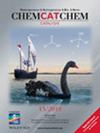Fe‐Catalyzed, Solvent‐Controlled, Switchable Routes for the Domino Construction of 2,4‐Disubstituted and 4‐Substituted Quinoline Scaffolds
IF 3.8
3区 化学
Q2 CHEMISTRY, PHYSICAL
引用次数: 0
Abstract
In this report, we unveil a highly efficient novel protocol for the domino synthesis of 2,4‐disubstituted and 4‐substituted quinoline scaffolds. The developed strategy involves earth‐abundant Fe‐catalyzed, solvent‐controlled, switchable routes for the selective construction of 2,4‐disubstituted and 4‐substituted quinoline frameworks, achieved by using either trifluoroethanol (TFE) or methanol (MeOH) as a solvent. By employing TFE as a solvent in Path A, the alkyne itself serves as a dual synthon through Fe‐catalyzed in situ C(sp)‐C(sp) bond cleavage, enabling the synthesis of two important molecules: 2,4‐disubstituted and 4‐substituted quinolines. Later, upon switching the reaction medium from TFE to MeOH for Path‐B, only 4‐substituted quinolines were obtained extensively. In this Path‐B, Fe‐catalyzed oxidation of methanol was observed and here methanol functioned as both a solvent and an environmentally benign carbon source. Both of these strategies were utilized to prepare a broad range of mono‐ and di‐substituted quinoline derivatives. In the application section and for practical utility, the scale‐up studies, along with the photophysical properties of the synthesized quinoline moiety are also demonstrated.铁催化、溶剂控制、可转换的 2,4-二取代和 4-取代喹啉支架的多米诺构建路线
在本报告中,我们揭示了一种高效的 2,4-二取代和 4-取代喹啉支架多米诺合成新方案。所开发的策略涉及地球富集的铁催化、溶剂控制、可切换路线,通过使用三氟乙醇(TFE)或甲醇(MeOH)作为溶剂,选择性地构建 2,4-二取代和 4-取代喹啉框架。在路径 A 中使用 TFE 作为溶剂,通过铁催化的原位 C(sp)-C(sp)键裂解,炔烃本身可作为双重合成物,从而合成两种重要分子:2,4-二取代喹啉和 4-取代喹啉。后来,在路径-B 中,将反应介质从 TFE 改为 MeOH 后,只广泛得到了 4-取代的喹啉类化合物。在路径 B 中,观察到了铁催化的甲醇氧化反应,甲醇在这里既是溶剂又是对环境无害的碳源。利用这两种策略制备了多种单取代和二取代喹啉衍生物。在应用部分,我们还展示了合成喹啉分子的放大研究和光物理特性,以提高其实用性。
本文章由计算机程序翻译,如有差异,请以英文原文为准。
求助全文
约1分钟内获得全文
求助全文
来源期刊

ChemCatChem
化学-物理化学
CiteScore
8.10
自引率
4.40%
发文量
511
审稿时长
1.3 months
期刊介绍:
With an impact factor of 4.495 (2018), ChemCatChem is one of the premier journals in the field of catalysis. The journal provides primary research papers and critical secondary information on heterogeneous, homogeneous and bio- and nanocatalysis. The journal is well placed to strengthen cross-communication within between these communities. Its authors and readers come from academia, the chemical industry, and government laboratories across the world. It is published on behalf of Chemistry Europe, an association of 16 European chemical societies, and is supported by the German Catalysis Society.
 求助内容:
求助内容: 应助结果提醒方式:
应助结果提醒方式:


